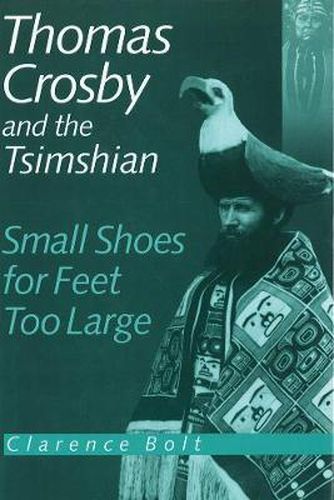Readings Newsletter
Become a Readings Member to make your shopping experience even easier.
Sign in or sign up for free!
You’re not far away from qualifying for FREE standard shipping within Australia
You’ve qualified for FREE standard shipping within Australia
The cart is loading…






When the Methodist missionary Thomas Crosby arrived in Port Simpson in northwestern British Columbia in 1874, he did so at the invitation of the Tsimshian people. Earlier contact with the Anglican missionary William Duncan had convinced them that, although many aspects of his missionary programme were appealing, his brand of religion was too austere. Instead they preferred the more expressive version represented by the Methodist Church. Realizing that it was in their interest to fit into the broader context of Canadian life, as they perceived it, the Tsimshian made the decision to ask the Methodist Church for a missionary. In this book, Clarence Bolt aims to demonstrate that the Indians were conscious participants in the acculturation and conversion process - as long as this met their goals - and not merely passive receivers of the blessings as typically reported by the missionaries. In order to understand the complexities of Indian-European contact, Bolt argues, one must look at the reasons for the Indians’ behaviour as well as those of the Europeans. He points out that the Indians actively influenced the manner in which their relationships with the white population developed, often resulting in a complex interaction in which the values of both groups rubbed off on each other. As long as the conversion process unfolded as they wished, the Tsimshian supported their missionary. Once they realized, however, that the church could not solve such issues as the land questions and their increasing difficulty with paternalistic governments, they moved away from Crosby. This book examines the functioning of two missions to the same people in a single locality, demonstrating how a particular Indian group tried to protect its traditional land resource while, at the same time, seeking participation in the emerging white society of 19th-century British Columbia. Based on insights into the interaction between the native population and the missionaries, Bolt finally suggests a model for a better understanding of the interaction between European and native cultures.
$9.00 standard shipping within Australia
FREE standard shipping within Australia for orders over $100.00
Express & International shipping calculated at checkout
When the Methodist missionary Thomas Crosby arrived in Port Simpson in northwestern British Columbia in 1874, he did so at the invitation of the Tsimshian people. Earlier contact with the Anglican missionary William Duncan had convinced them that, although many aspects of his missionary programme were appealing, his brand of religion was too austere. Instead they preferred the more expressive version represented by the Methodist Church. Realizing that it was in their interest to fit into the broader context of Canadian life, as they perceived it, the Tsimshian made the decision to ask the Methodist Church for a missionary. In this book, Clarence Bolt aims to demonstrate that the Indians were conscious participants in the acculturation and conversion process - as long as this met their goals - and not merely passive receivers of the blessings as typically reported by the missionaries. In order to understand the complexities of Indian-European contact, Bolt argues, one must look at the reasons for the Indians’ behaviour as well as those of the Europeans. He points out that the Indians actively influenced the manner in which their relationships with the white population developed, often resulting in a complex interaction in which the values of both groups rubbed off on each other. As long as the conversion process unfolded as they wished, the Tsimshian supported their missionary. Once they realized, however, that the church could not solve such issues as the land questions and their increasing difficulty with paternalistic governments, they moved away from Crosby. This book examines the functioning of two missions to the same people in a single locality, demonstrating how a particular Indian group tried to protect its traditional land resource while, at the same time, seeking participation in the emerging white society of 19th-century British Columbia. Based on insights into the interaction between the native population and the missionaries, Bolt finally suggests a model for a better understanding of the interaction between European and native cultures.